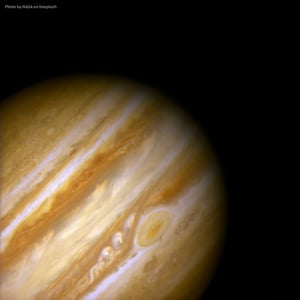Perhaps it’s been a while since you last heard the dulcet tones of an optical jukebox emanating...
Big, Bright & Beautiful – it’s Jupiter
Even those who rarely give the night sky more than a fleeting glimpse will surely have noticed what appears to be an unusually bright star rising in the east and setting in the west this September. It’s brighter than anything else in the night sky right now (barring the moon, obviously), and at the time of writing its brightness has not yet peaked!
 That’s right, I’m talking about Jupiter, the biggest and second brightest planet in our solar system. Jupiter was (will be) in opposition on the 26th September 2022, which means being directly opposite the Sun as viewed from Earth. While this does happen every thirteen months, what is much rarer is for Jupiter’s opposition to coincide with its perigee, the planet’s closest approach to our own. This time, perigee occurs just a day earlier on the 25th September, making conditions for viewing Jupiter the best they’ve been for 59 years!
That’s right, I’m talking about Jupiter, the biggest and second brightest planet in our solar system. Jupiter was (will be) in opposition on the 26th September 2022, which means being directly opposite the Sun as viewed from Earth. While this does happen every thirteen months, what is much rarer is for Jupiter’s opposition to coincide with its perigee, the planet’s closest approach to our own. This time, perigee occurs just a day earlier on the 25th September, making conditions for viewing Jupiter the best they’ve been for 59 years!
To the naked eye it appears as a large, bright white star – even with moderate light pollution. Those equipped with a telescope and a big hill in the middle of nowhere will of course have the best view – in fact, as NASA says:
“With good binoculars, the banding — at least the central band — and three or four of the Galilean satellites should be visible.“
Even though this publication will reach you a couple of days after Jupiter’s visibility peaks, don’t be disappointed if you didn’t get a good look – it will remain perfectly visible and rather bright for most of October. I’ve taken a photo or two of my own (sadly, not taken through a telescope) – if you manage to capture any yourself, we at PacSol would be thrilled to see them.
Now for some fun facts:
At its closest approach, Jupiter comes within around 367 million miles of Earth, whereas it might be around 600 million miles away at its farthest!
Jupiter has around eighty known moons, but even in these optimal conditions, amateur observers can only view the largest four of them (the Galilean moons). Did you know that those moons are a target for future space missions?
No later than 2024 the Europa Clipper will be launching to, you guessed it, Europa, which could be hiding a massive ocean under its ice. Meanwhile, the Jupiter Icy Moons spacecraft aims to explore three of the Galilean moons with an April 2023 launch in sight.
When I first saw Jupiter a few weeks back and wondered “what the heck is that?”, I used the Stellarium app to find out. I would recommend it to anyone with an interest in the night skies – the free version has certainly made this amateur’s life a bit easier!

Martin Pentlow, Technical Consultant. September 2022
#PacSolUK #Jupiter #Astronomy



